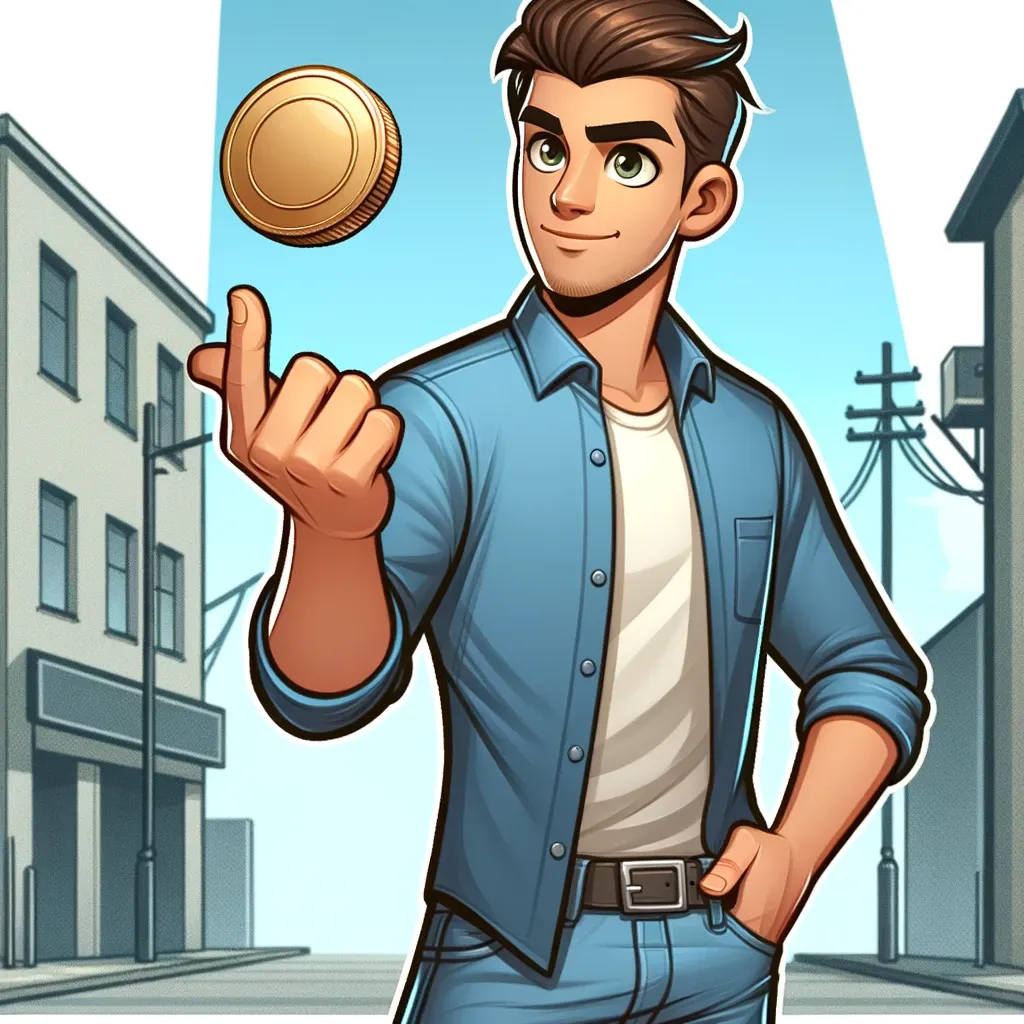Decisions, Decisions

“Thanks for coming to me with this. Here’s what we’re going to do.”
I stop and feel my pockets. Nothing.
“Ok, in this day and age, who still carries a wallet? Anybody got any coins on them?”
Everybody starts feeling their pants and skirts. Frank finds some loose change in his back pocket and hands it to me.
“That’s a washing machine disaster waiting to happen, Frank. But we can discuss that in our 1:1.”
Waving my arms I’m creating some space.
“Step back everyone. We got some decision making to do.”
I’ve been asked to look at ways to improve decision making at the company.
I like simple solutions, especially low effort ones. Therefore, flipping coins is my natural go to. In the past I always had a nicely flippable coin with me, but those days are over. Today I prefer to ask ChatGPT to do this for me. I mean, why reach for your pocket if you can burn an unethical amount of energy and light up tons of GPUs to do this task?
So this our base line. If you ask me to make a decision for you, I’m going to whip out ChatGPT and make it flip a GPU-powered approximation of a coin. I’m still collecting data on this, but so far I seem to be approaching a 50% success rate with this approach. Thereby likely outperforming a lot of decision makers already. I attribute a lot of my professional success to this approach.
Now, probably naively, you may think that this is not good enough. We ought to be able to do better.
I’ve always admired this aspiration in you.
Fine. Let’s entertain this idea. We can do some brain storming. If you insist.
What does making a decision entail? As everything, you can model decision making as a function:
Input: options
Output: selected option
Immediately you’ll find that even at this most basic level things can go wrong. The problem with coins is that in most countries, they tend to only have two sides. This is a limitation that ChatGPT can fairly easily resolve.
Exploring what options exist is worthwhile. Even options that you may initially brush off, may lead to “well actually” type moments later down the line.
Alright, we now have options. How do we decide? Honestly, our best bet (hah!) is still to flip a multi-sided coin. I mean, what other criteria do we have?
*flip*
Sadly, we have made our decision making performance worse by adding more options. We can’t really stop there.
Fine, let’s add a bit more complexity and introduce everybody’s narly nemesis trade-offs. As it turns out, often, you can’t have it all.
So let’s evaluate: what are the pros and cons of each of our options? Let’s list them explicitly, however obvious they may seem (to us).
Hah! That makes me realize we forgot one thing. How do we do such an analysis if we don’t even know what problem we’re trying to solve? So let’s agree on that and write it down too.
While you may be rolling your eyes at this point, you’d be surprised how many decisions are made without an agreed-upon problem to solve. “We have decided to use blockchain!” But wh... “Yes, blockchain!” If you thought using ChatGPT to flip a coin was an immoral use of power to achieve a simple goal, blockchain got it beat. Classic.
Excelente (as the Spanish say), now we have:
- A problem statement
- Options to pick from
- Trade-offs for each
Let’s pause here for a moment and shop this artifact around a little bit. Let’s put this in some sort of document (Google Doc, Confluence), share it with more people, and get input.
The type of input we’d be interested in would be:
- Coverage: are there any options that we’re not aware of?
- Quality: are the trade-offs listed correct, is there anything missing?
Who do we ask for input? I vote for two groups of people (in most cases):
- The people who will be affected by it (the victims)
- The people who know a lot about the topic (the experts)
So, let’s ask, and wait for them to look at the document and respond. When they don’t, let’s introduce an artificial deadline to make sure this happens, and then process what we get back.
Once we hit “Resolve” on the last comment, we’re ready to proceed.
From this point we can travel different paths. We can attempt to turn this into a science, or we can use feelings.
I worked in academia for four years, guess which one I’m going to pick.
What would sciencing it look like?
We could attempt to score the pros and cons, add weights to them somehow, and attempt to come up with a magic formula that will give us The Answer™️. Naturally, the fact that we have the opportunity to work with magic here gets me really excited.
Rory, in the highly under-appreciated (by straight men) TV series Gilmore Girls, went for the simplest version of the scientific method to make her decision on what college to attend in Season 3. The approach: just count the number of pros and cons for each option, and let that guide the decision. Gilmore Girls ran for 10 seasons and aired close to two decades ago, with a mini-series revival in 2016 which — frankly — was rather disappointing. You can watch it all on Netflix. I’m saying this to give you the option to still stop reading at this point and catch up before continuing with a major spoiler with an impact similar to Dumbledore Dies.
Rory ended up going to Yale.
This was shocking, because all her youth Rory was Team Harvard. Harvard was the option; a one-sided coin. Until her grandfather cheated her into considering alternate options. Yale seemed like an unlikely option, but she put it on the list. And guess what? Science said it was the right call.
Yet another example of the magic of listing all your options and pro/con lists. It’s ok to be cheated into it. How her grandfather did this though — not ok, I’m still upset.
Was Yale the best decision? We will never know, unless they one day do a Gilmore Girls alternate-reality fork-off. One can only dream.
While I can trace back many of my best life decisions to individual Gilmore Girls episodes, in this one instance I would not recommend you do the same.
Don’t do this. Don’t science your decision making.
Instead, in practice, what you will likely find is that as you go through the exercise of laying out options, thinking through them and getting external input on them, you’ll start developing a gut feel for what the right call is going to be. In most cases, in fact, The Answer™️ will be quite obvious. And if not, you always got the coin flip option.
Science is overrated. Feelings are the future.
So, write it down, but don’t call it “Feeling-inspired selected option”, keep it abstract. Call it decision — we prefer to keep thinking that our decision making is purely scientific and rational, no need to open that can of worms.
Ok, cool.
To recap, what do we have so far?
- A problem statement
- Options and their trade-offs
- A decision
Not bad. I think this has potential to outperform my (GPU-powered) coin.
Sadly, as any anthropologist worth its consultancy fee will tell you: we’ve been here before. We’ve tried this. It doesn’t work as is, there’s something missing.
There’s a branch of humanity that followed this process, but has died off due to natural causes. After some solid anthropological literal post mortems, the root cause was finally uncovered.
Anthropological literature tends to be quite inaccessible, so let me illustrate the problem with an example you may identify with.
At the time of this writing it’s 11:45am. Lunch time is coming soon. But what will I eat for lunch?
A decision to make! We got a process for that. Wooh!
What is the problem to solve here? What is the full range of options that I have and what are the individual trade-offs? Who should I ask for input? While I’m enthusiastically writing down all my lunch options, I notice my bladder is full. Should I go to the bathroom now, or just finish this one thing? Well, what’s the problem to be solved here? What are my options?
You see where this is going.
As we can see, there’s another dimension to take into account here, the eternal philosophical question:
“Why are we even talking about this?”
Yes, the opportunity cost angle. While I’m sitting here jotting down my problem statements and analyzing my options, I could be doing something else. Something potentially even more impactful. Like, just eating whatever leftovers are the most visible to me in the fridge for lunch.
But how do we decide (oh gosh) when to spend our time on making decisions right, and when to just wing it?
Criterion 1: importance. Lunch decisions, bladder flush opportunity timing? Meh, not worth it.
Criterion 2: what type of decision is this? Jeff Bezos is famous for introducing (or popularizing) the idea of one-way versus two-way door decisions at Amazon.
I could use many sources for a definition of this distinction, so I’ll cite the one with the best domain name (it was an easy decision).
From Strategic and Heuristic IT Management:
One-way door decisions are decisions that you can't easily reverse. These decisions need to be done carefully. Two-way door decisions can be reversed. You can walk through the door, see if you like it, and if not go back. These decisions can be made fast or even automated.
There you have it: if you can easily walk your decision back, or if it’s not all that important — ignore everything we talked about. What color should this button be? Let’s pick one and see what happens, we can change it later.
If you can’t easily go back, invoke process.
I feel we’re getting somewhere, but I think we have a couple more dimensions left to explore. Some that come to mind are who should make a decision, if a decision requires approval, and another is timing. Exciting stuff, but it’s been quite a journey already and I’m getting hungry, so let’s leave this for some other day.
Time for lunch.

